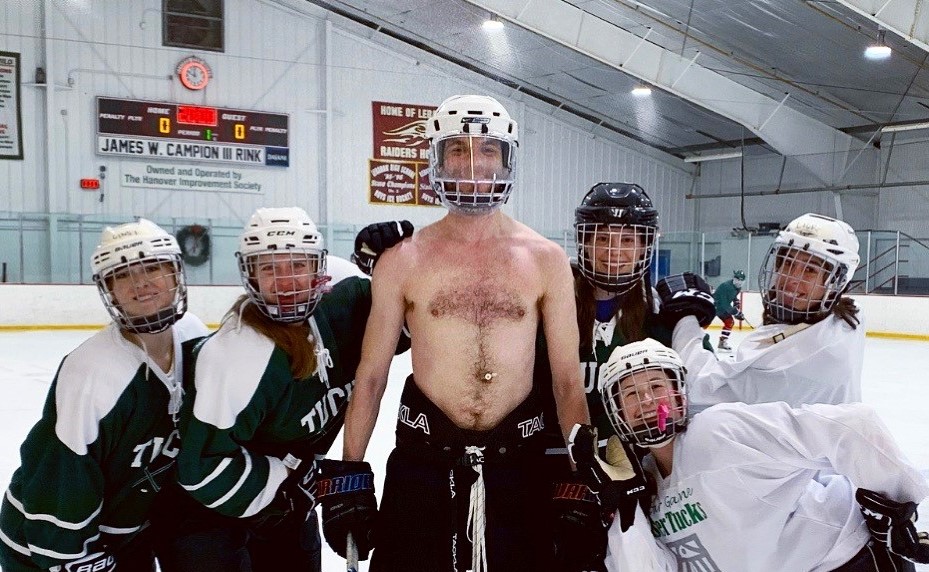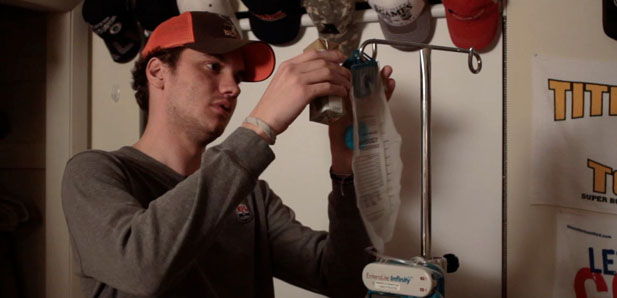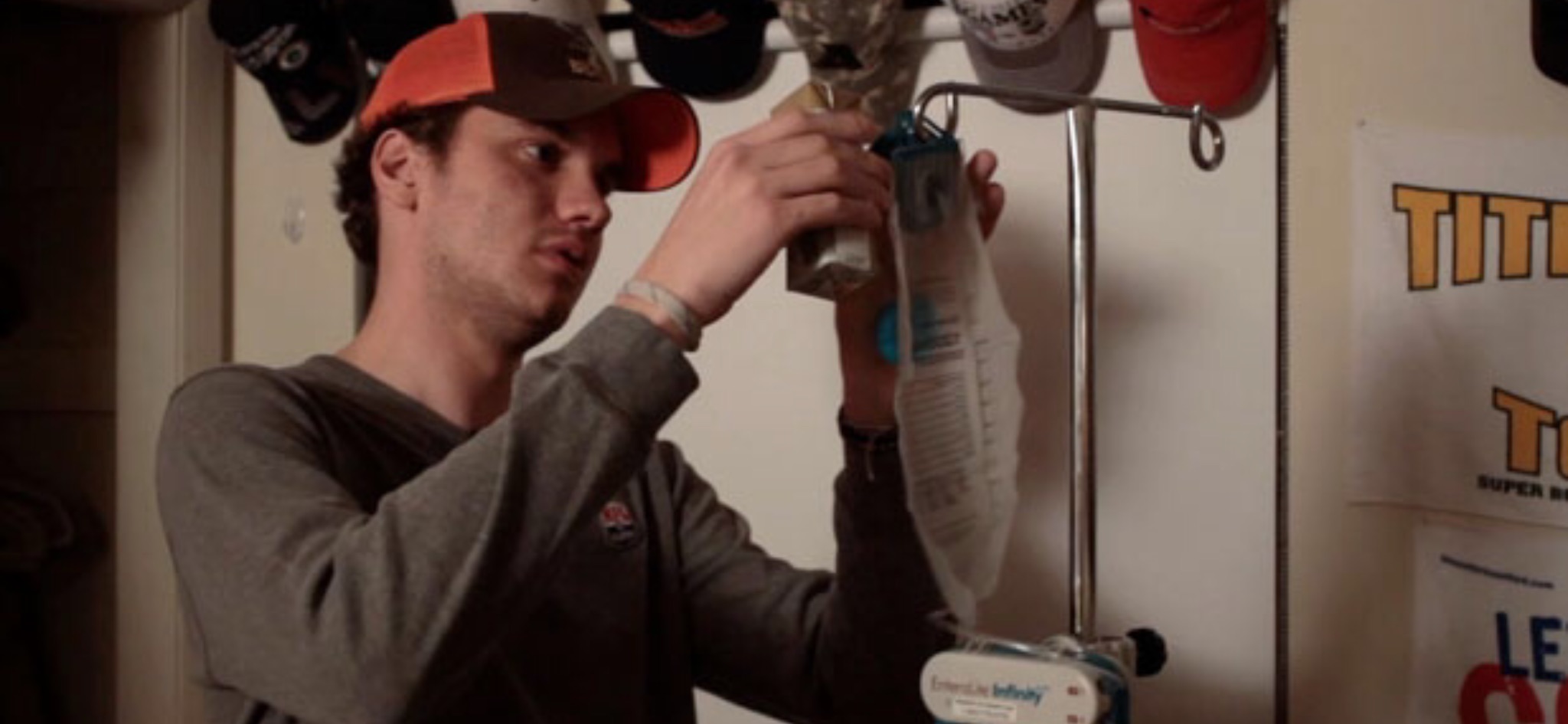I wasn’t exactly happy when I had my feeding tube placed in 2011, but it was necessary. I was drastically underweight and I couldn’t put any pounds on the old fashioned way. In fact, I was so distraught over the thought of putting a tube in that it took a bout with pancreatitis to convince me that I was in a dire situation.
Now here we are, almost 9 years later, and things with my feeding tube are perfectly fine. In those 9 years, though, the way I have used my feeding tube over the years has evolved and grown with me.
Initially my g-tube was used specifically for weight gain. I started on a 2.0 calorie formula to be taken 6 out of every 7 nights. My g-tube was working overtime. A lot of the enteral (tube) feeding formulas are measured on a 1.0-2.0 scale. We multiply the milliliters in a container by the 1.0-2.0cal scale to calculate the total calories per container. When I first started out, I was using four 250ml containers overnight, which came out to 2000 calories in a single feed. In those days, I was going for pure weight gain. The feeds were bloating, dense and loaded with sugar. Most mornings I experienced a sugar crash, but the feeds did the job. I gained plenty of weight over the first several months despite them feeling a bit uncomfortable.
Once I hit my goal weight, I scaled back my feeds to 4 or 5 nights out of the week, but still hammered away with my 2.0 calorie feeds when I did them. The 2000 calorie feeds PLUS what I was supposed to be eating during the day began to feel like a lot of work. The novelty of using the feeding tube sort of began to fade. Simply, it wasn’t new anymore. The super dense overnight feeds started to cannibalize my normal appetite. I was eating less, and to compensate, I found myself becoming more and more reliant on my overnight feeds and occasional bolus feeds during the day with weight gainer to hit my calorie goals. Eventually it led to a perpetual cycle of eating lees and using my tube feeds more frequently – almost the exact situation we don’t want for people with CF. Needless to say, my diet wasn’t at all diversified.
It wasn’t until a few years after college that I felt the need to dedicate more of my focus on my diet. I switched my overnight feeds to a more diverse “meal” – one that claims to be vegan. If you know me, you know that I am anything but a vegan (I say that after having had red meat for dinner three out of the last 6 nights). That being said, I am beyond a picky eater, so diversifying my intake was critically important. In doing so, I saw my bloat and sugar crashes disappear almost overnight (feeding tube pun).
From there, I started leaning on blenderized bolus feeds to supplement my overnight feeds and my regular eating habits. Enter my mom and Darcy into the feeding tube world. Last year Darcy blogged about her love for my feeding tube, but the truth is my parents and friends love what my feeding tube has done for me, too. My initial foray into blenderized tube feeds was all about changing up my diet with a consistent daily smoothie on top of my regular eating habits and overnight feeds. We bought a vitamix and away we went.
Looking back at that initial switch, I think we sort of cornered ourselves into using only a handful of recipies based around ingredients that we had access to through our local Whole Foods. It wasn’t long, though, before Darcy actually joined a tube feeding group on Facebook (this is one of those instances where I think Facebook groups are helpful) and learned a lot about the blenderized feeding tube world. A lot of the info she then shared with me totally rocked my world. Darcy did her due diligence, and her biggest takeaway was that it’s important for the feed to be dense enough to move through my GI tract slowly so that I could actually absorb the nutrition from it. When we initially started blending bolus feeds, I saw it run right through me. It wasn’t exactly comfortable. Now when we stir up some of our new blenderized smoothies, we make sure we have a good base to slow everything down. Generally quinoa is our go to, but we’ve used just about everything from almond flour to powdered goat’s milk and protein powder.
Now that I am in school, I use my feeding tube to supplement my energy requirements. I do my overnight feeds before every school day, and generally supplement with a diverse selection of blenderized bolus feeds during the day – even if that means I have to administer one during a group meeting. Frankly, no one has a care in the world if I do a feed during the school day… it’s just the thing that Gunnar must do sometimes. At the end… we’re all adults.
To answer your next question that you surely must have… Yes, I still use my feeding tube even though I am on Trikafta. Trikafta has led to some weight gain, but I am such a picky eater and as far as people with CF are concerned, I am way above the average height, so my calorie requirements are largely above what I could conceivably eat in a single day.
When I finally agreed to have my feeding tube placed, I saw the “indefinite” time horizon that my care providers talked about as a short-term goal. Get the tube in, gain some weight, and then finally get out. 9 years later, I couldn’t have been more wrong about the hopeful short term plan I set for my feeding tube. Now I see my g-tube as a weapon in my arsenal to use against my cystic fibrosis. There have been plenty of growing pains that have come along with my feeding tube, but at the same time it has provided invaluable nutrition support when I have needed it most. It is a critical tool, and frankly… I love it.
Yes… it was unbelievably cold when we took that photo.
I realized I forgot to add my 2019 reading list to a blog back in January… so without further to do… here it is! Remember, you can keep up with what I am reading on the right hand side of the blog (or if you’re on mobile, below individual blog posts). The books with * indicate my favorites.
Alchemy – Rory Sutherland*
Bad Blood – John Carreyrou*
Can’t Hurt Me – David Goggins
The Crowded Hour – Clay Risen
Economics in One Lesson – Henry Hazlitt
Five Feet Apart – Rachael Lippincott
The Great Crash 1929 – John Kenneth Galbraith
Honorable Exit – Thurston Clarke
How Will You Measure Your Life? – Clayton M. Christensen
Leadership: In Turbulent Times – Doris Kearns Goodwin
More Money Than God – Sebastian Mallaby
Never in Finer Company – Edward G. Lengel
On Desperate Ground – Hampton Sides*
Patton – Martin Blumenson
The Perfect Predator – Steffanie Strathdee
Sapiens – Yuval Noah Harari
Salt in My Soul – Mallory Smith
Sea Stories – Admiral William McRaven (US Navy Ret.)*
The Taking of K-129 – Josh Dean
Topgun: An American Story – Dan Pedersen
Zero to One – Peter Thiel & Blake Masters





